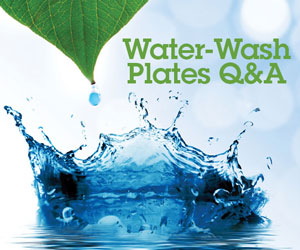
Water washable flexo plates are nothing new. Some may know their past history to be a bit rocky, but today's water wash plates have greatly evolved from the messy, low quality plates of the past.
Today's water washable flexo plates (Aquaflex Optima) are fast processing, clean printing, and more dimensionally stable than competing technologies. Sound too good to be true? Refer to these commonly asked questions to satisfy your curiosity- or ask your own question in our comments section.
Q1: How long does it take to make an Aquaflex Optima plate?
A1: Less than 1 hour from start to finish. Great for production situations such as last-minute remakes and rush jobs.
Q2: How long does the Aquaflex Optima plate have to dry?
A2: 10 minutes. The plate itself does not absorb any water. The drying cycle is simply used to remove any remaining surface water after washout.
Q3: What is in the wash water? How do I dispose of it?
A3: The water contains a surfactant to aid in washout and suspension of the polymer in solution. In some cases, the used washout water can go directly to drain, while in others it needs to be collected as non-hazardous waste. Compared to competing water wash plate systems such as Asahi AWP (pH ~11), Aquaflex Optima's system has a lower pH, therefore less hazardous waste water (pH ~9). Always check with your local water authority to make sure it is safe to drain any wastewater before doing so.
Q4: What about print quality? How does it compare to solvent or thermal plates?
A4: Customers using Aquaflex Optima report generally higher quality than thermal plates, and equivalent print quality to solvent plates. Aquaflex Optima plates are able to hold very fine detail due to their low oxygen sharpening effect.
Q5: What are the ink release and durability characteristics?
A5: Aquaflex Optima plates are clean-running and extremely durable on press thanks to their ability to release almost all ink picked up from the anilox roll. This means less plate cleaning, longer plate life, and less downtime on press overall.
Q6: Aren't water wash plates messy? How about equipment maintenance?
A6: Competitor's plates such as Toyobo Cosmolight are notorious for coating processing equipment with coagulated polymer residue. Aquaflex Optima is different- the Aquawash surfactant allows the washed-out polymer to stay in suspension. This allows for easy cleaning and little polymer buildup- cleaning is as simple as rinsing the machine with fresh water.
Q7: Are there any other unique properties that I should know about?
A7: Of course! Excellent drape for ease of mounting and reduction of plate lift, low-temperature processing and no plate swell during processing give the plate excellent dimensional stability - for accurate registration matches, even with plate remakes.
We welcome your questions and comments. Comment below, or email us here.

Dear Gentlemen
I am interesting to get mmore information about your water wash machines, we have a Xeikon plate maker machine, 25 x 30 inches. Please send me options,
thanks for your kind attention
Regards,
Antonnio
Hi Antonnio!
Thanks for your inquiry about our water wash plate systems. We have several different options available. If you could please send me an email at [email protected], I would be happy to follow up with more specific information.
Best regards,
Catherine
Dear
Can we use the water washable plate for stamp making ? Is it durable for the water based ink used for stamp ?